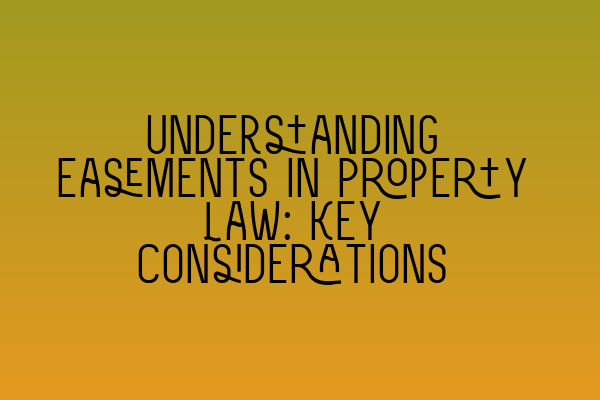Understanding Easements in Property Law: Key Considerations
When it comes to property law, there are many concepts and legal terms that can seem complex and overwhelming. One such concept is easements. In this article, we will provide an overview of easements in property law and highlight key considerations that every property owner should understand.
What is an Easement?
An easement is a legal right that allows one party to use another party’s property for a specific purpose. It grants a non-possessory interest in land, meaning that the holder of the easement does not have ownership of the land but has the right to use it in a limited manner.
There are various types of easements, including:
- Appurtenant Easements: These easements are attached to the land and benefit the owner of a neighboring property. For example, a driveway easement allowing a neighboring property to access a shared driveway.
- Easement in Gross: This type of easement benefits a specific individual or entity rather than a neighboring property. For instance, a utility company may have an easement to access a property to maintain power lines.
- Prescriptive Easements: A prescriptive easement arises when someone has used another person’s land openly, continuously, and without permission for a specified period of time, typically 20 years. It is essentially a legal recognition of adverse possession, albeit in a limited form.
Key Considerations for Easements
Here are some important points to keep in mind when dealing with easements:
- Creation: Easements can be created in various ways, including by express grant, implication, necessity, or prescription. It is crucial to understand the specific requirements for creating an easement and ensure that all legal formalities are met.
- Scope of Use: The scope of use allowed by an easement should be clearly defined. It may include specific activities or restrictions, such as the right to install utility lines or the prohibition of commercial use.
- Property Encumbrance: Easements create encumbrances on the property, which can affect its value and potential uses. It is essential to assess the impact of an easement on your property and consider any potential restrictions or obligations.
- Termination: Easements can be terminated under certain circumstances, such as by expiration, mutual agreement, abandonment, or through court action. Understanding the grounds for termination is crucial to protect your rights as a property owner.
Seek Professional Advice
When dealing with easements or any aspect of property law, it is always recommended to seek professional advice from a qualified property solicitor. They can provide expert guidance tailored to your specific situation and ensure that your rights and interests are protected.
If you are preparing for the SQE exams in property law, it is crucial to have a solid understanding of easements as they may be included in exam questions. To enhance your preparation, consider practicing with SQE 1 exam questions and SQE 1 practice mocks FLK1 FLK2. Additionally, explore SQE 2 preparation courses and SQE 1 preparation courses to optimize your exam readiness. Stay updated on the latest SRA SQE exam dates to plan your study schedule effectively.
Remember, having a solid understanding of easements and property law is essential for property owners, developers, and legal professionals alike. By familiarizing yourself with the key considerations and seeking professional advice when needed, you can navigate easement-related matters confidently and ensure the protection of your rights.
For comprehensive assistance with property law and land law matters, you can trust SQE Property Law & Land Law. Our team of experienced solicitors is dedicated to providing reliable legal services tailored to your needs. Contact us today for expert assistance.
